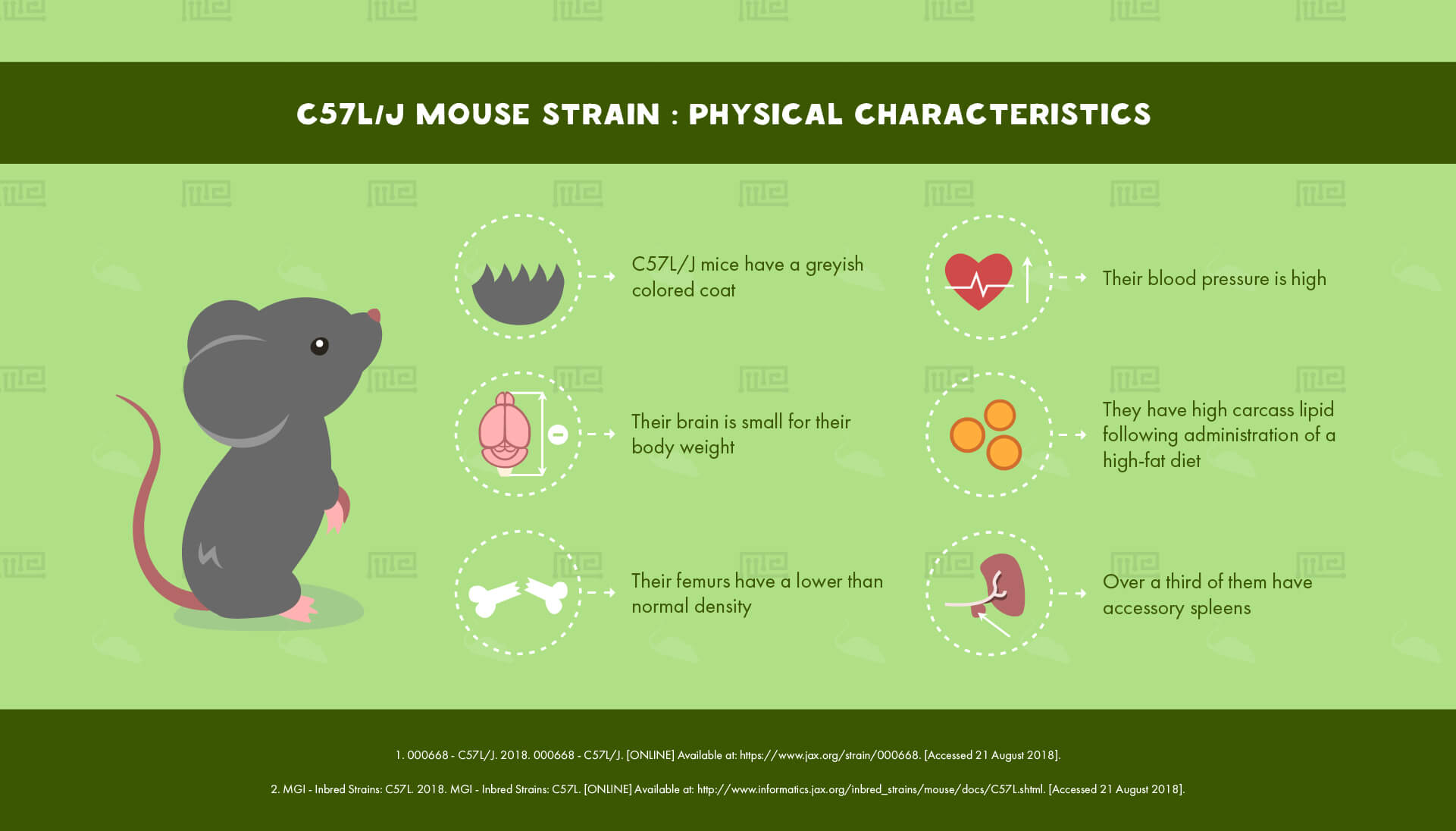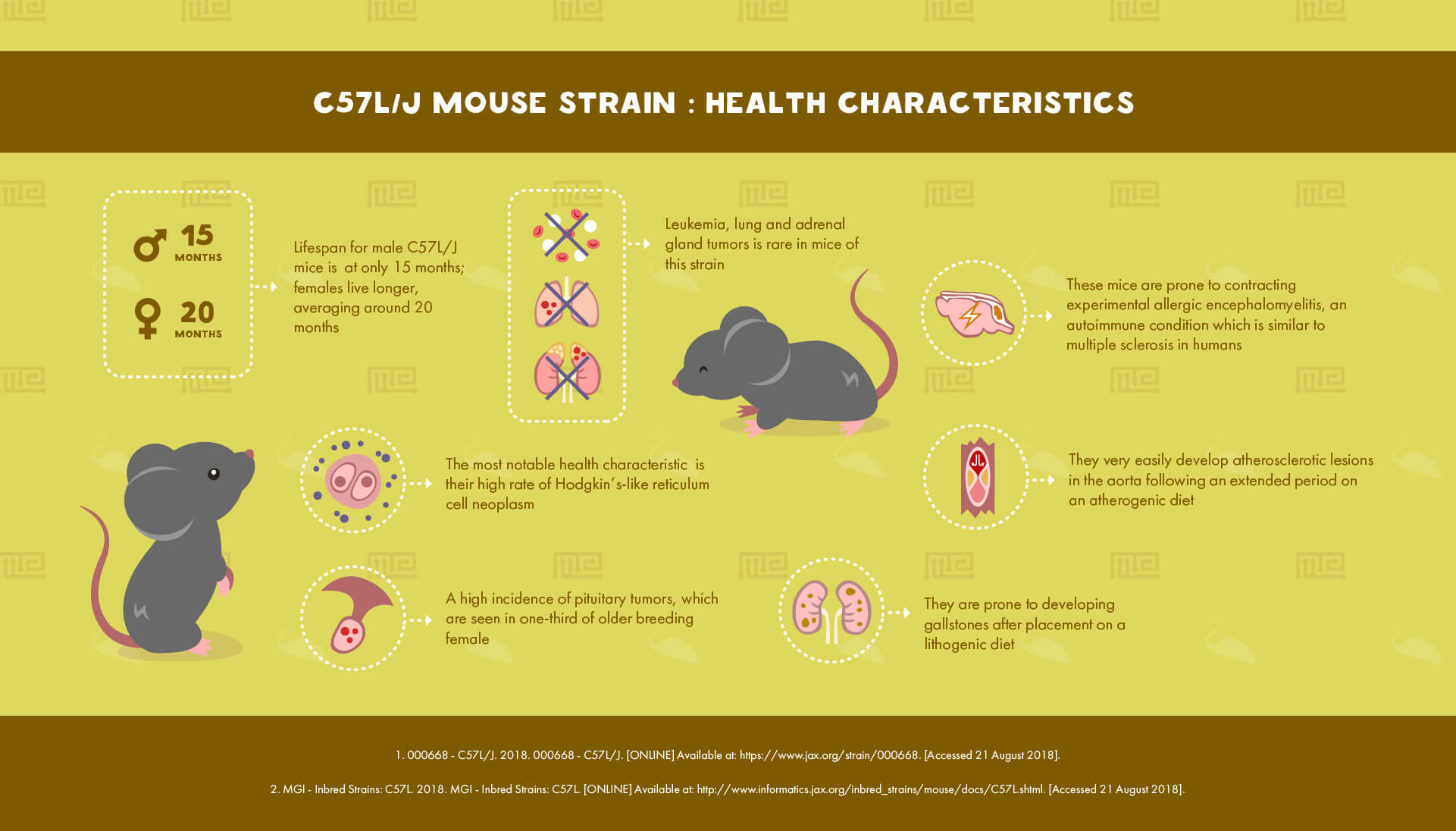Overview
C57L/J (not to be confused with C57BL/6J) is a strain of inbred mouse that is used for a broad variety of experimental applications.
History
C57L mice resulted from a spontaneous mutation that occurred in 1933 in some stock of the now extinct C57BR strain. The new strain was taken to Murray at the Jackson Laboratory where inbreeding was undertaken. The mice were then moved to the JAX production facility in 1945, where over 200 generations have since passed.[1][2]
Physical Characteristics
C57L/J mice have a greyish colored coat, similar to that of DBA/J.[1] Their brain is small for their body weight, and their femurs have a lower than normal density. Their blood pressure is high, and they have high carcass lipid following administration of a high-fat diet. Over a third of them have accessory spleens.[2]
Behavioral Characteristics & Handling
Mice of this strain show high open field activity, as well as low tail rattling during aggressive encounters. They also have a stronger than usual preference for alcohol.[2]
One study[3] reports that C57L/J mice displayed the least anxiety on the elevated plus maze of all strains measured, less than A/J, AKR/J, DBA/J, and BALB/cByJ. This strain also performed well in the Morris water maze test, suggesting good spatial learning and memory. However, these results were contradicted by poor performance in the T maze test.
A Canadian study[4] comparing the ease of handling of a number of commonly used strains rated C57L/J high on placidity, about the same level as C57BL/6J. The strain also showed very little struggling or evasive behavior during capture and holding. Experimenters should thus have confidence in C57L/J being an easy strain to deal with.
Health Characteristics
Lifespan for male C57L/J mice is short, at only 15 months; females live longer, averaging around 20 months.[2] The most notable health characteristic of this strain is their high rate of Hodgkin’s-like reticulum cell neoplasm, with this cancer occurring in a quarter of C57L/J mice by the age of 18 months. These mice also show a high incidence of pituitary tumors, which are seen in one-third of older breeding females.[1][2]
Despite these high incidences of certain cancers, leukemia is rare in mice of this strain, as they exhibit no endogenous expression of murine leukemia virus. Lung and adrenal gland tumors are also rare.[1][2]
The C57L/J also shows digestive pathologies: they very easily develop atherosclerotic lesions in the aorta following an extended period on an atherogenic diet (high fat, high cholesterol), and are also prone to developing gallstones after placement on a lithogenic diet, this second phenomenon on account of deficits in cholesterol synthesis regulation.[2]
These mice are prone to contracting experimental allergic encephalomyelitis, an autoimmune condition which is similar to multiple sclerosis in humans. They show a strong immune response to the toxin phytohemagglutinin.[1]
Major Experimental Uses
This strain has proven most useful in various kinds of cancer research, particularly on leukemia, reticulum cell neoplasm and pituitary cancer. Besides cancer, C57L/J mice have been applied in cardiovascular research on atherosclerosis, immunological research on autoimmune disorders, and dermatological research on pigmentation defects.[1]
References
- 000668 – C57L/J. 2018. 000668 – C57L/J. [ONLINE] Available at: https://www.jax.org/strain/000668. [Accessed 21 August 2018].
- MGI – Inbred Strains: C57L. 2018. MGI – Inbred Strains: C57L. [ONLINE] Available at: http://www.informatics.jax.org/inbred_strains/mouse/docs/C57L.shtml. [Accessed 21 August 2018].
- Moy, S. S., Nadler, J. J., Young, N. B., Perez, A., Holloway, L. P., Barbaro, R. P., … Crawley, J. N. (2007). Mouse Behavioral Tasks Relevant to Autism: Phenotypes of Ten Inbred Strains. Behavioral Brain Research, 176(1), 4–20.
- Wahlsten, D. Metten, P. Crabbe, JC. 2003. A rating scale for the wildness and ease of handling laboratory mice: results for 21 inbred strains tested in two laboratories. Genes, Brain and Behavior. 2; 71-79.


